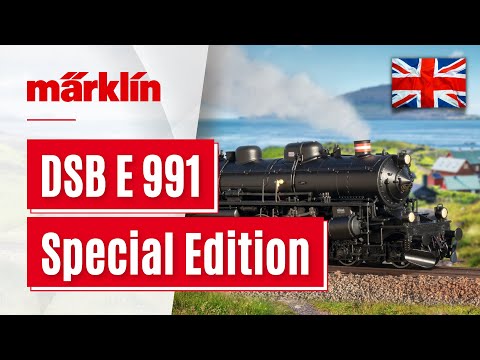DSB - E 991 steam locomotive
The most beautiful steam locomotive on the Danish State Railways
(DSB) was the class (Litra) E. It originated among eleven Pacific
express locomotives of the Swedish State Railways (SJ) class F,
which disappeared from service in 1937 due to increasing
electrification. The DSB was able to acquire these powerful
locomotives and then roster them as road numbers E 964–974.
Starting in 1940, the DSB urgently needed additional powerful steam
locomotives and so it had another 25 class E locomotives built with
small improvements by Frichs in Aarhus as road numbers E 975–999.
These Pacifics held their own pulling passenger and freight trains
up into the Sixties. However, one after the other they were put
into storage. Several units were preserved however, including road
number E 991 as an official DSB museum locomotive. It was in
operation almost continuously until 2010 for special service and
had the great honor on November 14, 2000 to be the motive power for
the special train with the casket for Queen Ingrid from Copenhagen
to the burial in Roskilde.
Prototype: Danish State Railways (DSB) steam locomotive with a tender, road number E 991. The locomotive looks as it did around 2007.
Steam Locomotive, Road Number E 991 In 1937, the Danish State Railways (DSB) bought eleven SJ class F Pacific locomotives from the Swedish State Railways (SJ) due to increases in passenger traffic. These locomotives had become superfluous in Sweden due to increasing electrification. These first Scandinavian Pacifics were built between 1914 and 1916 by Nydqvist & Holm as four-cylinder compound superheated steam locomotives with Heusinger valve gear according to the Vauclain system, in which all of the cylinders are in a row. Both the outer low-pressure and the inner high-pressure cylinders were connected to the second set of driving wheels. The steam dome and the sand dome were on the top of the boiler under joint streamlining. In Denmark, these units were initially overhauled in the DSB's Copenhagen main shops, and they were converted to right hand control and then put on the roster as road numbers E 964-974. Additional adaptations involved the refueling infrastructure as well as the construction of 20 meter / 65 foot turntables. The German occupation of Denmark starting in 1940 meant the DSB urgently needed additional powerful steam locomotives, so they had the class E built at Frichs in Aarhus. Between 1943 and 1950, 25 locomotives entered the roster in four series as road numbers E 975-999. These "new" Pacifics had an additional dome to dry steam, larger side windows on the cabs, and welded tenders. In addition, road numbers E 990-999 were delivered with double smokestacks, which were then retrofitted on road numbers E 975-989 between 1948 and 1951. Up into the Sixties, these Pacifics defended their role pulling passenger and freight trains, yet they landed on the storage track one after the other. The last regular use of a class E was in 1970 and the last unit kept for special service, road number E 994, was retired in 1979. Only six units were preserved: Road numbers E 964 and 966 were sold in 1963 and 1999 to the Swedish Railroad Museum in Gävle and were given their old road numbers F 1200 and F 1202 again. Road number F 1200 was carefully restored to its original condition and has been operational since September of 2002, while road number F 1202 functions as a stationary display piece. Road number E 987 belongs to a private individual, while road number E 996 can presently be admired in Great Britain at the "Railworld Wildlife Haven" in Peterborough. The Danish Railroad Museum in Odense owns road numbers E 991 and 994. The former is run as an operational locomotive (currently being overhauled), and the latter is a museum display piece.
Highlights:
- completely new tooling;
- especially intricate metal construction;
- factory-installed smoke unit;
- emergency light can be controlled separately in digital operation;
- cab lighting can be controlled separately in digital operation;
- firebox flickering can be controlled separately in digital operation.
Model: The locomotive has an mfx+ digital decoder and extensive light and sound functions. It also has controlled high-efficiency propulsion with a flywheel, in the boiler. Three axles powered. Traction tires. The locomotive and the tender are constructed mostly of metal. The locomotive has a factory-installed smoke unit. Triple headlights on the locomotive and the tender, which change over with the direction of travel, and the built-in smoke unit will work in conventional operation and can be controlled digitally. The emergency light on the smoke box door can be controlled separately in digital operation. Cab lighting and firebox flickering can also be controlled separately in digital operation. Maintenance-free warm white and red LEDs are used for the lighting. There is an adjustable close coupling with a guide mechanism between the locomotive and tender. There is a close coupler with a guide mechanism and an NEM pocket on the tender. The minimum radius for operation is 360 mm / 14-3/16". There are many separately applied details such as steps, brake hoses, piping, and imitation prototype couplers included.
Length over the buffers approximately 24.5 cm / 9-5/8".
175 Years of Railroading in Denmark.
This model can be found in a DC version in the Trix H0 assortment under item number 25491.
Prototype: Danish State Railways (DSB) steam locomotive with a tender, road number E 991. The locomotive looks as it did around 2007.
Steam Locomotive, Road Number E 991 In 1937, the Danish State Railways (DSB) bought eleven SJ class F Pacific locomotives from the Swedish State Railways (SJ) due to increases in passenger traffic. These locomotives had become superfluous in Sweden due to increasing electrification. These first Scandinavian Pacifics were built between 1914 and 1916 by Nydqvist & Holm as four-cylinder compound superheated steam locomotives with Heusinger valve gear according to the Vauclain system, in which all of the cylinders are in a row. Both the outer low-pressure and the inner high-pressure cylinders were connected to the second set of driving wheels. The steam dome and the sand dome were on the top of the boiler under joint streamlining. In Denmark, these units were initially overhauled in the DSB's Copenhagen main shops, and they were converted to right hand control and then put on the roster as road numbers E 964-974. Additional adaptations involved the refueling infrastructure as well as the construction of 20 meter / 65 foot turntables. The German occupation of Denmark starting in 1940 meant the DSB urgently needed additional powerful steam locomotives, so they had the class E built at Frichs in Aarhus. Between 1943 and 1950, 25 locomotives entered the roster in four series as road numbers E 975-999. These "new" Pacifics had an additional dome to dry steam, larger side windows on the cabs, and welded tenders. In addition, road numbers E 990-999 were delivered with double smokestacks, which were then retrofitted on road numbers E 975-989 between 1948 and 1951. Up into the Sixties, these Pacifics defended their role pulling passenger and freight trains, yet they landed on the storage track one after the other. The last regular use of a class E was in 1970 and the last unit kept for special service, road number E 994, was retired in 1979. Only six units were preserved: Road numbers E 964 and 966 were sold in 1963 and 1999 to the Swedish Railroad Museum in Gävle and were given their old road numbers F 1200 and F 1202 again. Road number F 1200 was carefully restored to its original condition and has been operational since September of 2002, while road number F 1202 functions as a stationary display piece. Road number E 987 belongs to a private individual, while road number E 996 can presently be admired in Great Britain at the "Railworld Wildlife Haven" in Peterborough. The Danish Railroad Museum in Odense owns road numbers E 991 and 994. The former is run as an operational locomotive (currently being overhauled), and the latter is a museum display piece.
Highlights:
- completely new tooling;
- especially intricate metal construction;
- factory-installed smoke unit;
- emergency light can be controlled separately in digital operation;
- cab lighting can be controlled separately in digital operation;
- firebox flickering can be controlled separately in digital operation.
Model: The locomotive has an mfx+ digital decoder and extensive light and sound functions. It also has controlled high-efficiency propulsion with a flywheel, in the boiler. Three axles powered. Traction tires. The locomotive and the tender are constructed mostly of metal. The locomotive has a factory-installed smoke unit. Triple headlights on the locomotive and the tender, which change over with the direction of travel, and the built-in smoke unit will work in conventional operation and can be controlled digitally. The emergency light on the smoke box door can be controlled separately in digital operation. Cab lighting and firebox flickering can also be controlled separately in digital operation. Maintenance-free warm white and red LEDs are used for the lighting. There is an adjustable close coupling with a guide mechanism between the locomotive and tender. There is a close coupler with a guide mechanism and an NEM pocket on the tender. The minimum radius for operation is 360 mm / 14-3/16". There are many separately applied details such as steps, brake hoses, piping, and imitation prototype couplers included.
Length over the buffers approximately 24.5 cm / 9-5/8".
175 Years of Railroading in Denmark.
This model can be found in a DC version in the Trix H0 assortment under item number 25491.
First announced: April 2022
Presented in the following catalogs / brochures:
Recommended retail price: 629.00 €

3-rail (alternating current - AC)

DCC (Digital)

mfx+ digital decoder

Integrated sound

Coupler standard pocket (NEM 362)

Coupler with close coupling cinematic

Triple headlights alterning with the direction of travel

Locomotive - metal frame and mostly metal body
Discussion forum








